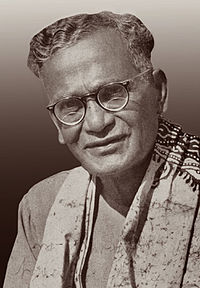- Nandalal Bose
-
Nandalal Bose
নন্দলাল বসু
Born 3 December 1882
Bihar, IndiaDied 16 April 1966 (aged 82)
Kolkata, West Bengal, IndiaNationality Indian Field Painting Movement Modern Indian Art Nandalal Bose (Bengali: নন্দলাল বসু, Nondo-lal Boshū) (3 December 1882 – 16 April 1966) was a notable Indian painter of Bengal school of art. A pupil of Abanindranath Tagore, Bose was known for "Indian style" of painting. He became the principal of Kala Bhawan, Shanti Niketan in 1922. He was influenced by the Tagore family and the murals of Ajanta, his classic works include paintings of scenes from Indian mythologies, women, and village life.[citation needed]
Today, his paintings are considered among India's best modern paintings by many critics.[1][2][3].
Along with his favourite students like Beohar Rammanohar Sinha and others, Nandalal Bose took-up the historic task of beautifying/decorating the original manuscript of the Constitution of India.[4] In 1976, the Archaeological Survey of India, Department of Culture, Govt. of India declared his works among the "nine artists", whose work "not being antiquities, were to be hence forth considered to be 'art treasures' [5].
Contents
Early life
Nandalal Bose was born at Tarapur , Bihar, India.
Career
Nandalal Bose as a young artist was deeply influenced by the murals of Ajanta, already part of a circle of artists and writers who sought to revive classical Indian culture.
To mark the 1930 occasion of Gandhi's arrest for protesting the British tax on salt, Bose created a black on white linocut print of Gandhi walking with a staff. It became the iconic image for the non-violent movement.
He was also famously asked by Jawaharlal Nehru to sketch the emblems for the Government of India’s awards, including the Bharat Ratna and the Padmashri.[6]
His genius and original style were recognized by famous artists and art critics like Gaganendranath Tagore, Ananda Coomaraswamy and O.C.Ganguli. These lovers of art felt that objective criticism was necessary for the development of painting and founded the Indian Society of Oriental Art.
He became principal of the Kala Bhavana (College of Arts) at Tagore's International University Santiniketan in 1922.
He died on April, the 16th 1966, in Calcutta.
Students
Some of his illustrious students were Benode Behari Mukherjee, Ramkinkar Baij, Beohar Rammanohar Sinha, Pratima Thakur, Jahar Dasgupta, Sabita Thakur.
Honours and awards
In 1954 , Nandalal Bose was conferred-upon the title award of 'Padma Vibhushan'. Nandalal Bose was awarded a prize of Rs. 500 at the first art exhibition organized by it in 1908 CE for his painting Shiva-Sati. In 1956 CE, he became the second artist to be elected Fellow of the Lalit Kala Akademi, India's National Academy of Art.
Several universities conferred honorary Doctorates on him. Vishvabharati University honored him by conferring on him the title of 'Deshikottama'. The Academy of Fine Arts in Calcutta honored Nandalal with the Silver Jubilee Medal. The Tagore Birth Centenary Medal was awarded to Nandalal Bose in 1965 CE by the Asiatic Society of Bengal.
References
- ^ "San Diego museum showcases Nandalal Bose". Rediff.com News. June 25, 2008. http://in.rediff.com/news/2008/jun/25paint.htm.
- ^ Robert L. Pincus (March 15, 2008). "The Art of Nandalal Bose' is first U.S. showcase for an Indian icon". Paramus Post. http://www.paramuspost.com/article.php/20080314111558184.
- ^ Ganesh, Kamala; Usha Thakkar (2005). Culture and the making of identity in contemporary India: The Asiatic Society Of Mumbai Bicentenary. SAGE. pp. 88, 92–93. ISBN 0761933816. http://books.google.co.in/books?id=ePtg79MKkkwC&pg=PT49&dq=Nandalal+Bose&lr=&cd=3#v=onepage&q=Nandalal%20Bose&f=false.
- ^ "The Constitution of India". World Digital Library. 2009-05-07. http://www.wdl.org/en/item/2672/. Retrieved 2010-12-09.
- ^ Nine Masters Government Museum and Art Gallery, Chandigarh."Nine Masters: Rabindranath Tagore, Amrita Sher-Gil, Jamini Roy and Nandalal Bose, Ravi Varma, Gaganendranath Tagore, Abanindranath Tagore, Sailoz Mookherjea and Nicholas Roerich. "
- ^ "Nandalal Bose paintings on display in U.S.". The Hindu. Mar 15, 2008. http://www.hindu.com/2008/03/15/stories/2008031556021400.htm.
Further reading
- Nandalal Bose and Indian painting, by Ramyansu Sekhar Das. Tower Publishers, 1958.
- Nandalal Bose: a collection of essays : centenary volume. Lalit Kala Akademi, 1983.
- Nandalal Bose, the doyen of Indian art. (National biography), by Dinkar Kowshik. National Book Trust, India, 1985.
External links
Categories:- Indian painters
- Fellows of the Lalit Kala Akademi
- Recipients of the Padma Vibhushan
- People from Howrah district
- 1883 births
- 1966 deaths
- Government College of Art & Craft alumni
- University of Calcutta alumni
- Visva-Bharati University faculty
Wikimedia Foundation. 2010.
